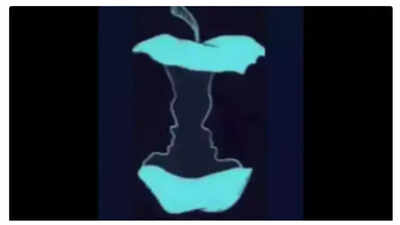Optical illusions have surged in popularity, offering a stimulating brain exercise and a test of observational skills. These visual puzzles provide entertainment and insight into how our minds work. An optical illusion arises when the brain misinterprets the information received by the eyes. This discrepancy occurs when visual input conflicts with the brain's processing, leading to perceptions that deviate from reality.

This particular illusion, initially shared by Marina Winberg on social media, presents viewers with two possibilities: an eaten apple or two faces. Your initial perception is believed to reveal a fundamental aspect of your personality. Take a moment to study the image and determine what you see first.
Winberg explains that the image is a "classic dual-illusion." Seeing "two faces (a man and a woman) looking at each other OR an apple core" can be highly indicative of your mindset.
If You See Two Faces First:
According to Winberg, perceiving the two faces first suggests you are a logical, analytical thinker with strong moral principles. You prioritize careful consideration before acting, value stability, and approach problem-solving with creativity. However, your curiosity can sometimes lead you astray.
If You See an Apple First:
Those who immediately perceive the apple are described as intuitive, emotionally aware, and adept at recognizing subtle cues. You possess a natural understanding of what to say in various situations but often choose to remain silent. Stability is important to you, and you are protective of what you value.
Optical illusions can be categorized into three primary types:
Literal Illusions: These illusions occur when the brain combines elements of an image to create a perception that doesn't actually exist. A classic example is the Rubin vase illusion, where viewers can see either two faces or a vase, depending on their interpretation.
Physiological Illusions: These illusions result from overstimulation of the visual system. Excessive exposure to light, movement, or color can lead to effects like afterimages or the perception of motion in a static image.
Cognitive Illusions: These illusions are rooted in the brain's subconscious interpretation of information. The Müller-Lyer illusion, where lines appear to be different lengths due to surrounding shapes, is a prime example of this type of illusion.
Newer articles
Older articles
 SA20 Auction: Teams Given Green Light to Retain Six Players Amidst Increased Salary Cap and New RTM Card
SA20 Auction: Teams Given Green Light to Retain Six Players Amidst Increased Salary Cap and New RTM Card
 India's Harshit Rana Released from Squad Before Second Test Against England in Birmingham
India's Harshit Rana Released from Squad Before Second Test Against England in Birmingham
 Udaipur: India's "City of Lakes" Beckons with Palaces and Timeless Romance
Udaipur: India's "City of Lakes" Beckons with Palaces and Timeless Romance
 Nitish Rana Poised for Delhi Comeback After Disappointing Uttar Pradesh Stint
Nitish Rana Poised for Delhi Comeback After Disappointing Uttar Pradesh Stint
 Former Selector Blasts India's Fielding Blunders After Test Loss to England
Former Selector Blasts India's Fielding Blunders After Test Loss to England
 Anushka Sharma Faces Ageist Criticism at Wimbledon, Fans Launch Online Defense
Anushka Sharma Faces Ageist Criticism at Wimbledon, Fans Launch Online Defense
 Asia Cup 2025: ACC Eyes Mid-September Start Date Amid Easing Tensions
Asia Cup 2025: ACC Eyes Mid-September Start Date Amid Easing Tensions
 Gambhir Defends India's Tailenders After Headingley Collapse, Cites Dropped Catches as Key Factor
Gambhir Defends India's Tailenders After Headingley Collapse, Cites Dropped Catches as Key Factor
 Gavaskar Calls for Kuldeep Yadav's Inclusion, Questions Bumrah's Fitness Ahead of Second Test Against England
Gavaskar Calls for Kuldeep Yadav's Inclusion, Questions Bumrah's Fitness Ahead of Second Test Against England
 Green tea vs lemon water for glowing skin: Myths, benefits, and expert-backed skincare secrets
Green tea vs lemon water for glowing skin: Myths, benefits, and expert-backed skincare secrets